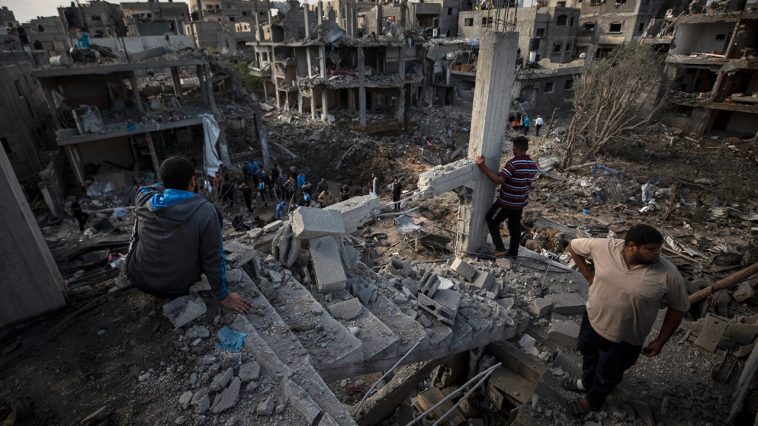LISTEN HERE:
Israeli defense forces recently initiated a thorough search for a Hamas tunnel, believed to be in northern Gaza, near an abandoned hospital.
The entrance to the tunnel was located and consequently packed with an explosive substance. Triggering the material resulted in a monumental explosion, causing the building to be enveloped in flames. Surveillance evidence revealed smoke billowing out at least three different points in proximity to a local road within the city of Beit Hanoun.
In a broader context, the tunnel hunt is simply one part of a wider Israeli military reaction to Hamas’ militant activities. This initiative followed a deadly assault on Southern Israel carried out by the Palestinian extremist group on October 7th. Apart from explosives, the Israeli military has been utilizing state-of-the-art technology like tracking robotics to explore the vast network of underground bunkers and tunnels.
Whilst strict regulations for sharing information restricted the officer in command from fully detailing the under-ground war efforts, he confirmed that it was an ongoing operation. He declined to identify the exact location of the hospital in Beit Hanoun, from where operations were taking place.
Video emerges showing of the destruction of tunnel system in Gaza.. pic.twitter.com/LAEjKgUjnD
— Chuck Callesto (@ChuckCallesto) November 19, 2023
During its operations in Beit Hanoun, Israeli forces encountered militants arising from the underground tunnels. These assailants tried to attack the Israeli military and were subsequently neutralized. The officer stated that Israel did not intend to engage in battles in the suffocating, unlit and unstable tunnel corridors, playing into the hands of their adversaries, familiar with the terrain.
He openly expressed reluctance to risk personnel lives entering the tunnels knowing full well the potential threats—Hamas had extensively deployed improvised explosives there. One such concealed explosive device killed four Israeli special forces reservists at a tunnel entrance in the previous week.
Hamas leverages this maze of tunnels for a range of operations such as launching attacks, smuggling resources, and hiding weaponry. Each tunnel could be accessed from dozens of shafts at depths varying from 20 to 80 meters. The officer explained that neutralizing these access points was a relatively straightforward task, capable of being handled by any unit.
Last week, Israeli armed forces confirmed the demolition of around 130 such access routes, even though they refrained from providing a total figure for dismantled tunnels. Obliterating whole tunnels is a more challenging task as it requires several tons of explosive compounds, which are transported by trucks.
The exact estimate of the neutralized tunnels is difficult to confirm. The officer leading the operation in Beit Hanoun said that almost 50% of the shafts in his zone had been destroyed. Although these could potentially be rebuilt, he acknowledged the intricacy of establishing the number of destroyed tunnels, given the interconnectedness of the underground system.
Hamas has refuted allegations of employing hospitals for shielding these tunnels. The group also denied claims of operating a control center beneath Gaza’s largest hospital, Al-Shifa—a site cited by Israeli forces.
One emerging concern is the potential endangerment of hostages within these tunnels. Hamas allegedly took approximately 240 individuals to Gaza as captives following their assault in October, during which an estimated 1,200 individuals lost their lives. One of the few released hostages shared that she, along with additional captives, was confined within one such tunnel.
The Israeli military officer stressed the caution exercised in avoiding damage to tunnels suspected to house captives. They continue to review intelligence to ensure targets are void of hostages prior to authorizing any attacks. Beit Hanoun, much like large swathes of Northern Gaza, has been evacuated of civilians who were instructed to move southwards as Israel’s ground benevolent invasion sustained efforts to eliminate Hamas.
Reiterating the safety measures employed, the officer noted that any subsequent explosions, potentially resulting from the tunnel demolition, usually led to the collapse of a nearby structure at some distance away, no longer holding civilian inhabitants but terrorists.
To aid their efforts, Israeli forces have extracted information regarding the tunnel network from captured Palestinian militants. Yet, this information was limited in scope, as individual fighters typically only had knowledge about the underground system within their own village.
Considering the overarching objective to neutralize this expansive labyrinth of tunnels, the officer remarked that this process could span several months. Drawing a stark comparison to highlight the daunting challenge at hand, he concluded that the complexity of Gaza’s underground network was, quite possibly, on par with the subway system of New York City.



